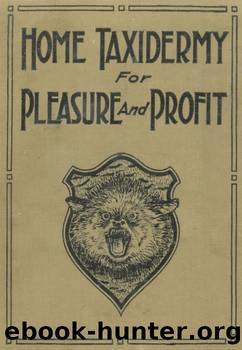Home Taxidermy for Pleasure and Profit A Guide for Those Who Wish to Prepare and Mount Animals, Birds, Fish, Reptiles, etc., for Home, Den, or Office Decoration by Albert Burton Farnham

Author:Albert Burton Farnham [Farnham, Albert Burton]
Language: eng
Format: epub
Tags: Taxidermy
Published: 2007-10-30T16:00:00+00:00
If two good sized rectangular holes are cut in the back-board just in front of the hind legs and behind the shoulders they will be useful later in shaping the body by sewing back and forth with a mattress needle and cord. Drive a row of lath nails into the top and bottom edges of the back-board about half their length at 2 inch intervals. They will enable you to build up first one side, then the other of the body by winding down excelsior with wrapping cord. These nails are driven fully in when the winding is finished.
The limbs also are built up by using the same material. Do not build up any part to a perfect fit yet, however, as we must leave room for a shell of paper â to ¼ inch thick. Depressions in body and limbs are reproduced by sewing from side to side or drawing down with nails.
The neck and skull are built up in much the same way and the skin fitting loosely, the manikin is surfaced up with a coat of soft modelling clay well rubbed in with a small trowel. The paper coating is to be applied while the clay is still damp so a large specimen must be partly covered with a damp cloth to prevent it drying out prematurely.
The paper for this purpose should be of some soft easily pulped variety; common building paper is good and may be torn in pieces of various size, soaked in water 15 minutes, then squeezed out and coated on both sides with paste. This is applied to the surface of the figure, the edges overlapping slightly, until completely covered. Use paper of a different color for each alternate coat to insure its completion. Five or six coats will be sufficient when it may be left to dry, after which treat it to a good coat of shellac.
The skin is withdrawn from the pickle, rinsed in soda solution, put through the benzine and meal drying and coated on the entire inner surface with preservative. Glue coated ear forms are slipped into place and fastened by long stitches back and forth through the ears. The feet and bases of ears are filled with papier mache pulp and the surface of the manikin coated with liquid glue.
Now the skin is put on the form to stay, fastening down the central line of the back with wire brads and drawn together at the junction of legs and body with stout stitches. The legs are sewn up first and the opening cut of the body last. A surplus of skin may be worked out and distributed with the point of an awl, while it may be pulled and stretched to cover a shortage in another point without changing the animal's form in the least.
The ears are pinned in place and their bases distended by tow pressed in with stuffers. Pointed wires thrust through the openings of the ears into the skull will hold them in place until dry.
Download
This site does not store any files on its server. We only index and link to content provided by other sites. Please contact the content providers to delete copyright contents if any and email us, we'll remove relevant links or contents immediately.
What's Done in Darkness by Kayla Perrin(25500)
Shot Through the Heart: DI Grace Fisher 2 by Isabelle Grey(18219)
Shot Through the Heart by Mercy Celeste(18160)
The Fifty Shades Trilogy & Grey by E L James(17774)
The 3rd Cycle of the Betrayed Series Collection: Extremely Controversial Historical Thrillers (Betrayed Series Boxed set) by McCray Carolyn(13189)
The Subtle Art of Not Giving a F*ck by Mark Manson(12912)
Scorched Earth by Nick Kyme(11832)
Stepbrother Stories 2 - 21 Taboo Story Collection (Brother Sister Stepbrother Stepsister Taboo Pseudo Incest Family Virgin Creampie Pregnant Forced Pregnancy Breeding) by Roxi Harding(11040)
Drei Generationen auf dem Jakobsweg by Stein Pia(10217)
Suna by Ziefle Pia(10186)
Scythe by Neal Shusterman(9259)
International Relations from the Global South; Worlds of Difference; First Edition by Arlene B. Tickner & Karen Smith(8608)
Successful Proposal Strategies for Small Businesses: Using Knowledge Management ot Win Govenment, Private Sector, and International Contracts 3rd Edition by Robert Frey(8419)
This is Going to Hurt by Adam Kay(7695)
Dirty Filthy Fix: A Fixed Trilogy Novella by Laurelin Paige(6453)
He Loves Me...KNOT by RC Boldt(5804)
How to Make Love to a Negro Without Getting Tired by Dany LaFerrière(5378)
Interdimensional Brothel by F4U(5304)
Thankful For Her by Alexa Riley(5161)
